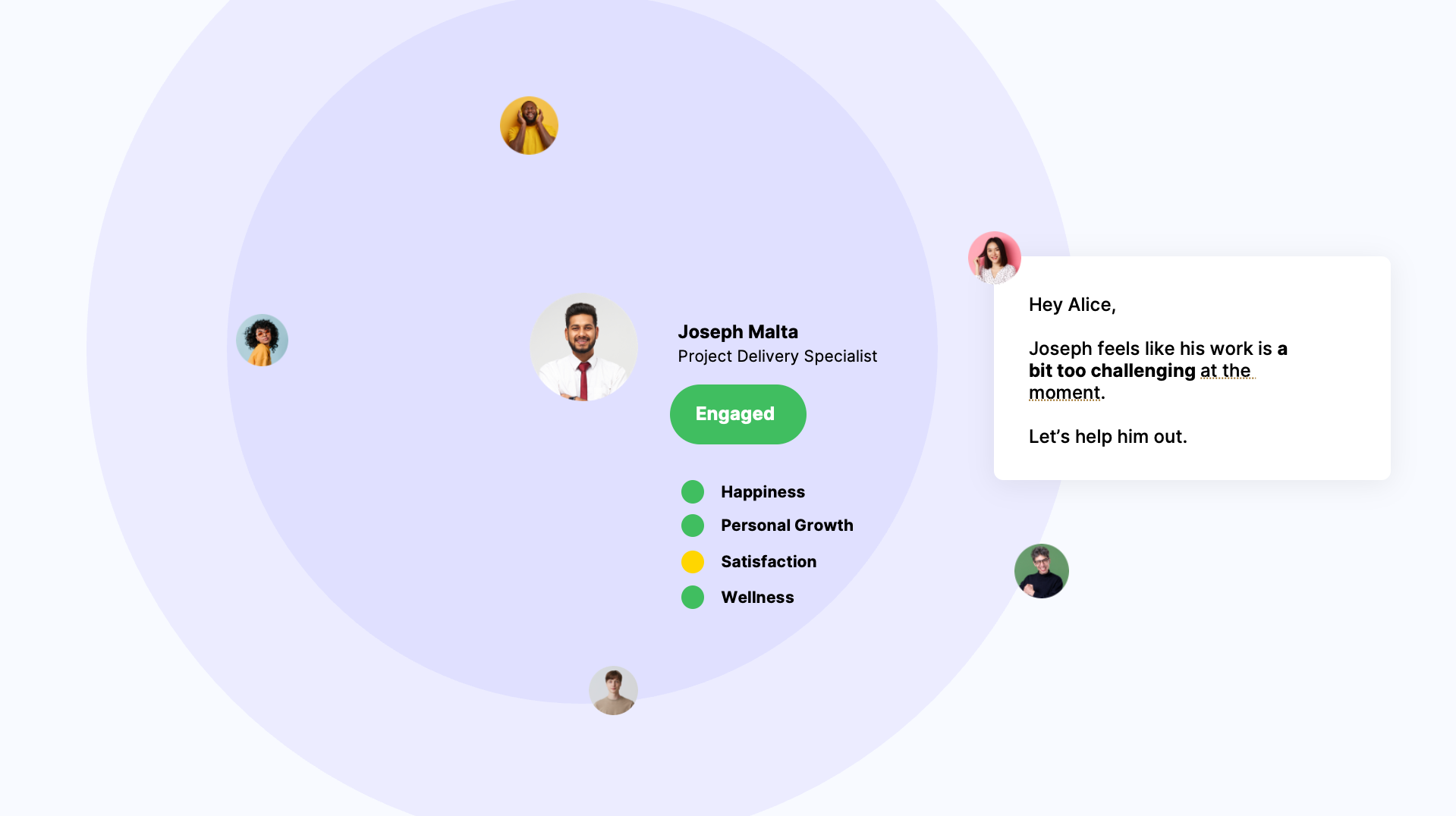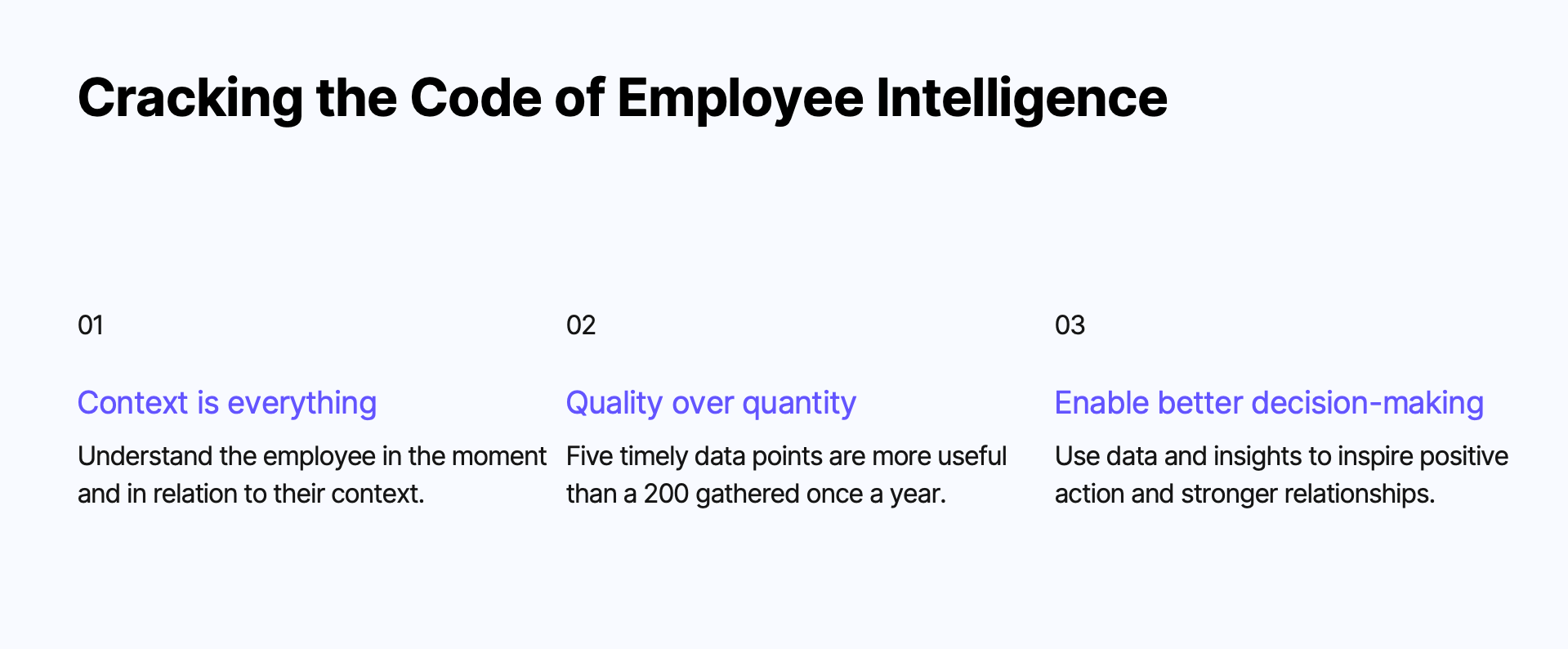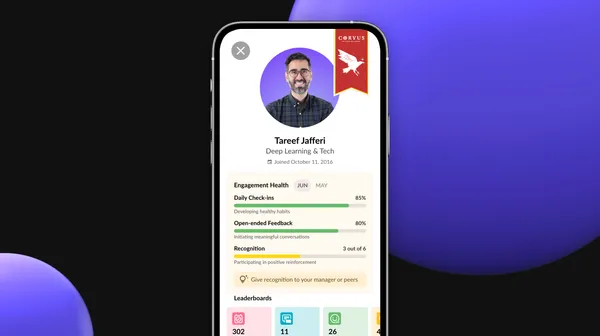Harnessing the Power of Digital to Understand and Transform Your Workplace Culture
At its core, an organization is a collective of individuals working together towards shared goals. The act of "organizing" – creating structure, defining roles, and setting processes – allows us to leverage collective intelligence and optimize team dynamics. In the digital age, this understanding of the collective and the individual is amplified through a field known as 'Employee Intelligence,' powered by people analytics.
People analytics provides critical information about your employees, facilitating a deeper understanding when placed within the context of your organizational culture. This article explores how we can leverage people analytics to garner meaningful information, understand our people better, and, ultimately, transform our workplace culture.
An Introduction to People Analytics
People Analytics, at its simplest, is the methodical and statistical analysis of employee data. This includes attribute analytics (characteristics of individuals), relational analytics (interactions and relationships between employees), and behavioral analytics (employee behaviors and actions).
A zoomed-in perspective could involve Organizational Network Analytics, recognizing patterns in communication and collaboration, or performance measurement based on recognition data. Talent identification may involve understanding the impact of individuals on their colleagues.
Good information in people analytics is timely, reliable, and actionable. It offers insight when you need it, can be trusted to represent reality, and provides value by informing decisions and strategies.
Attribute Analytics
Attribute analytics involves analyzing data related to individual characteristics. These characteristics can be demographic, such as age, gender, or educational background, or they can relate to the employee's role, such as their department, tenure, or job level.
For instance, attribute analytics could be used to assess the diversity of your organization or to understand the correlation between educational background and job performance. It can inform hiring strategies, retention programs, and diversity initiatives.
Relational Analytics
Relational analytics focuses on the interactions and relationships between employees. It explores patterns of communication, collaboration, and influence within an organization. Examples include analyzing email communications, meeting invitations, or collaborations on projects.
Relational analytics can be used to identify key influencers within an organization or to understand how information flows within the team. This can inform strategies around teamwork, innovation, and change management.
Behavioral Analytics
Behavioral analytics involves examining employee behaviors and actions. This could include everything from analyzing patterns in employee punctuality to exploring data related to employee engagement with company resources.
Behavioral analytics could help organizations identify patterns related to productivity, engagement, or employee burnout. This can guide interventions to improve performance, engagement, or work-life balance.
In all these forms of analytics, the goal is to gain insights that are timely, reliable, and actionable, offering real value to an organization's strategies and decision-making.

Applying People Analytics: Measuring Employee Engagement
While attribute analytics can provide important insights about an organization's workforce, such as the distribution of demographic characteristics or tenure, they have limitations when it comes to measuring something as dynamic and nuanced as employee engagement. Here's why behavioral analytics is more reliable in this context:
- Real-time Insights: Employee engagement is not static; it changes over time and can be influenced by various factors like project success, changes in team dynamics, or personal circumstances. Annual engagement surveys are merely a snapshot of a specific point in time and may not capture these fluctuations. On the other hand, behavioral analytics, through ongoing observation of behaviors and interactions, provides real-time insights into engagement levels.
- Unconscious Behaviors: Engagement surveys rely on self-reported data, which can be skewed by various biases. Employees might give what they believe are the 'right' answers or their responses could be influenced by their mood at the time of the survey. Behavioral analytics, by tracking actual behaviors, captures unconscious and spontaneous behaviors that may provide a more authentic picture of engagement.
- Actionable Data: Behavioral analytics often provides more actionable data. Knowing that engagement is low among employees with a certain tenure (attribute analytics) may not give clear guidance on what to do. However, understanding that engagement dips when employees aren't included in decision-making processes or when they don't receive regular feedback (behavioral analytics) offers specific areas to address.
- Predictive Capabilities: Behavioral analytics can help predict future trends in engagement based on observed patterns and correlations. For instance, you might find that employees who engage in more collaborative behaviors show higher engagement levels. This predictive ability can help leaders proactively manage engagement, rather than reactively addressing issues identified in annual surveys.
While attribute analytics has its place, for a dynamic and complex issue like employee engagement, behavioral analytics is a more robust and comprehensive tool.
Using Data to Drive Behavior Change
Change within an organization faces two main obstacles: individual resistance and environmental barriers. People analytics can help overcome these by informing targeted strategies, such as incentive programs or setting defaults that guide behaviors.
Barriers to Change: The Person
- Mindset: People's attitudes, beliefs, and perceptions can greatly influence their behaviors. For instance, an employee might resist using a new digital tool if they believe it's too complicated or unnecessary. Overcoming this barrier often requires education, communication, and the demonstration of clear benefits.
- Motivation: This refers to the internal drive that prompts employees to act. It's influenced by factors such as the perceived value of the outcome, the effort required, and the likelihood of success. Low motivation can be a significant barrier to change, often requiring incentive structures, reinforcement, and support to address.
- Tools: Even with the right mindset and motivation, employees need the proper tools – both physical and digital – to enact the desired behavior. A lack of necessary resources can prevent employees from embracing change.
By understanding the principles that guide human behavior, organizations can design interventions to overcome these barriers effectively.
Incentives play a critical role in this regard. As per the principles of operant conditioning, behavior followed by a rewarding consequence is likely to be repeated. Hence, incentives can be a powerful tool to drive desired behaviors, such as engagement and participation in pulse surveys, open-ended feedback, and peer recognition. A study found that employees were significantly more likely to participate in surveys and provide feedback when they knew a reward was at stake.
Moreover, the use of incentives aligns with the motivational aspect of personal barriers. When employees see a clear benefit – the incentive – they are more likely to adopt the new behavior.

Barriers to Change: The Environment
- Process: Existing processes might hinder new behaviors, especially if they are ingrained and habitual. Modifying these processes or creating new ones can help facilitate the desired change.
- Role: An individual's role and responsibilities within an organization can either facilitate or hinder change. If the desired behavior change conflicts with an individual's role, they may resist it.
- Hierarchy: The structure of the organization and the relationships within it can impact behavior change. A rigid hierarchy might slow down change, while a more fluid structure could facilitate it.
- Social Norms: The unwritten rules and shared expectations within a workplace can greatly influence behavior. If the desired behavior goes against these norms, it may be resisted.
One of the key tenets of behavioral science is the power of "default options" in shaping behaviors. By designing systems and processes with new default states, organizations can gently steer employees towards preferred behaviors without taking away their freedom of choice.
For instance, consider the process of peer recognition. Traditionally, employees might send out a generic recognition message when a colleague does good work. But what if the recognition process itself prompted them to link the colleague's actions to the organization's core values? By providing core values as default options during the recognition process, organizations can subtly encourage employees to frame their recognition in a way that reinforces these values.
And this approach works. Our study saw recognition aligned with core values increase ninefold. This not only amplifies positive behaviors that embody the company's values but also reinforces those values across the organization.


By being intentional about both the personal and environmental elements, leaders can use people analytics to inform strategies and interventions that overcome these barriers and foster positive change.
Case Study: Transforming Culture with Happily.ai
Happily.ai uses innovative strategies to transform organizational culture and improve overall health using people analytics and behavioral science. Here are three key strategies:
Gamifying Employee Feedback
Happily.ai uses gamification to motivate employees to provide daily feedback. The system encourages participation by making feedback and engagement a fun, competitive process, with rewards for active participants.
Result: The gamification led to over 80% weekly activity from employees, a level of engagement that was sustained over a four-year period. This resulted in a steady stream of valuable, actionable data for the organization.

Changing the Default State of Feedback
Another key strategy involved changing the default state of feedback to be positive and non-anonymous. This meant that instead of sharing feedback anonymously, employees were encouraged to be open and constructive, fostering a more transparent and collaborative culture.
Result: Less than 5% of open-ended feedback was shared anonymously, compared to 100% using previous methods. This shift fostered greater trust and openness within the team.

Attaching Value to Recognition
Happily.ai also made a significant change to their recognition system. They attached tangible value to recognition and made it about reinforcing company values. This meant that employees are recognized not just for their achievements, but also for embodying the company's core values.
Result: More than 80% of employees participated in giving recognition to their peers, and over 72% reinforced behaviors aligned with company values. This not only boosted morale but also helped to embed the organization's values more deeply within their everyday work.

Platforms like Happily.ai incentivize real-time feedback and recognition, providing automated insights and identifying talent within the context of culture. Other platforms like MyCulture prioritize hiring based on culture fit and values alignment.

Key Thoughts
People analytics can be powerful, but it's easy to get it wrong. Signs of missteps include spending more time gathering and analyzing data than implementing interventions, distrusting the data you're getting, or worrying excessively about 'adoption':
- Time Gathering Data > Time Delivering Interventions: If you're spending more time collecting and processing data than implementing interventions based on that data, this is a red flag. People analytics should empower decision-making and action, not bog you down in a never-ending data gathering cycle.
- Your Data Can’t Explain What’s Really Going on in Your Organization: Good analytics should provide a clear picture of your organization's status and dynamics. If your data leaves more questions than answers, or fails to explain the observed behaviors and outcomes in your organization, then it might be that you're focusing on the wrong data points, or your data collection methods are flawed.
- Digital Adoption is a Primary Obstacle: While integrating digital solutions into your processes can be challenging, it shouldn't be your primary obstacle. If the fear of adoption is hampering your people analytics initiatives, it might indicate a lack of clear communication about the benefits of these initiatives, or a need for more training and support for your team.
- Unable to Measure Improvement on Business Outcomes: People analytics should ultimately drive improvement in business outcomes, whether that's increased productivity, improved employee retention, or better financial performance. If your analytics efforts aren't translating into measurable improvements in these areas, you may need to revisit your strategies and ensure that your analytics initiatives are aligned with your business goals.
The purpose of people analytics is not just to gather data, but to garner insights that can be used to enhance the employee experience and improve organizational performance. By keeping these pitfalls in mind, you can ensure your people analytics efforts are impactful and beneficial.
The digital revolution isn't about making tasks easier – it's an opportunity to rethink and rebuild our systems. We must reimagine feedback mechanisms, redefine our understanding of performance, and reassess how we reward behaviors.
Conclusion
In our quest to 'organize' and enhance employee intelligence, we must remember the essence of what we're dealing with: people. People are complex, dynamic, and profoundly influenced by their context. As such, understanding the employee in the moment and in relation to their context is essential. It is about looking at their interactions, behaviors, and responses within the organizational environment that shapes their experience.
When it comes to data, remember: quality over quantity. Gathering copious amounts of data is not as important as collecting the right data. Five timely, relevant, and actionable data points are infinitely more useful than 200 data points gathered once a year that may no longer be relevant or reliable.
Lastly, let's remember the purpose of this all: to enable better decision-making that inspires positive action and fosters stronger relationships. People analytics and employee intelligence should be leveraged not just to observe or predict but to inspire - to catalyze changes that enhance employee experience, boost engagement, and ultimately, drive organizational success.
With this balanced, focused, and human-centered approach to people analytics, we can transform our workplaces into thriving, engaging, and productive spaces that people don't just inhabit, but truly love.

We 'organize' for a reason. That reason must be clear every day. By harnessing the power of people analytics and approaching it in the right way, we can make our organizations more than just places of work - we can make them communities where every member feels valued, understood, and engaged.










